
In a railway accident, telescoping occurs when the underframe of one vehicle overrides that of another, and smashes through the second vehicle's body. The term is derived from the resulting appearance of the two vehicle bodies: the body of one vehicle may appear to be slid inside the other like the tubes of a collapsible telescope – the body sides, roof and underframe of the latter vehicle being forced apart from each other.
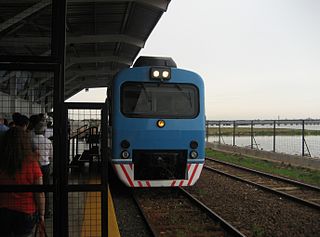
The General Urquiza Railway (FCGU), named after the Argentine general and politician Justo José de Urquiza, is a standard gauge railway of Argentina which runs approximately northwards from Buenos Aires to Posadas, with several branches in between. It was also one of the six state-owned Argentine railway companies formed after President Juan Perón's nationalisation of the railway network in 1948. The six companies were managed by Ferrocarriles Argentinos which was later broken up during the process of railway privatisation beginning in 1991 during Carlos Menem's presidency.
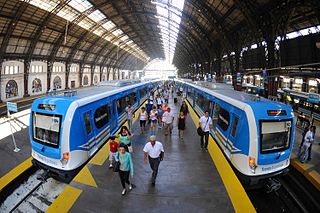
The Mitre line is an Argentine broad gauge commuter rail service in Buenos Aires Province and is part of the Ferrocarril General Bartolomé Mitre division. The service is currently operated by the State-owned company Operadora Ferroviaria Sociedad del Estado after the Government of Argentina rescinded its contract with Corredores Ferroviarios in March 2015.

The Sarmiento line is a broad gauge commuter rail service in Buenos Aires Province, Argentina, run by the state-owned Trenes Argentinos since 11 September 2013.
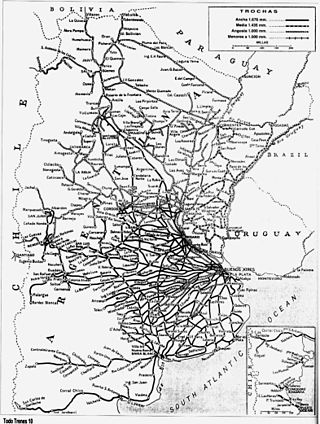
The Argentine railway network consisted of a 47,000 km (29,204 mi) network at the end of the Second World War and was, in its time, one of the most extensive and prosperous in the world. However, with the increase in highway construction, there followed a sharp decline in railway profitability, leading to the break-up in 1993 of Ferrocarriles Argentinos (FA), the state railroad corporation. During the period following privatisation, private and provincial railway companies were created and resurrected some of the major passenger routes that FA once operated.
The Col des Nuages derailment was a train derailment that occurred in eastern French Indochina, in modern-day Vietnam, on 24 June 1953, during the First Indochina War. Railway officials announced the day after that "about 100 or more" were killed when a passenger train plunged 50 feet through a sabotaged viaduct.
The Torre del Bierzo rail disaster occurred on 3 January 1944 near the village of Torre del Bierzo in the El Bierzo region of Spain's León province when three trains collided and caught fire inside a tunnel. Although the official death toll was 78, and at the time it was estimated to be 200–250, the most recent study has estimated it at no more than 100.

The El Virilla train accident occurred in Costa Rica on 14 March 1926, when an overcrowded train carrying mostly farmers and laborers derailed while crossing a bridge across the Virilla River Canyon, killing 385 and injuring 93.

The Angola Horror train wreck occurred on December 18, 1867, just after 3 p.m. when the last coach of the Buffalo-bound New York Express of the Lake Shore Railway derailed at a bridge in Angola, New York, United States, slid down into a gorge, and caught fire, killing some 49 people. At the time, it was one of the deadliest train wrecks in American history.

The Turenne rail accident occurred on 14 September 1932 when a train carrying French Foreign Legionnaires crashed in Algeria killing 62 people.

The Altamirano rail disaster occurred in 1964 in the city of Altamirano, Buenos Aires, Argentina, when a passenger train collided head on with a freight train, killing 34 people.

The Villa Soldati level crossing disaster occurred on the morning of June 11, 1962 in the Villa Soldati neighborhood of Buenos Aires, when, in dense fog, a train struck a municipal bus carrying schoolchildren.
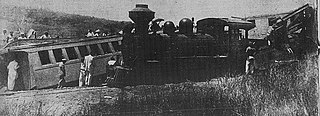
The Aracaju train crash, which occurred on March 20, 1946, is the worst ever rail disaster in Brazil; resulting in the deaths of 185 people and 300 injured. The accident happened near Aracaju, capital of the coastal state of Sergipe, 800 miles (1,287 km) northeast of Rio de Janeiro.
The 1958 Rio de Janeiro train crash, occurred on May 8, 1958, in Mangueira, a suburb two miles west of Rio de Janeiro city centre in Brazil when two electric trains collided head on, killing 128 people and injuring more than 300. It is the most serious rail accident in the history of the city. As of 2023, it remains the Second-Deadliest rail accident in brazilian railway history, being surpassed by the Aracaju train crash.
The San Bernardo train crash was a fatal rail crash that happened on July 17, 1955 at San Bernardo, a suburb on the southern edge of Santiago, the capital of Chile, killing 38 passengers. It was the worst rail disaster in Chilean history until the rail disaster at Queronque in 1986 which killed 58.
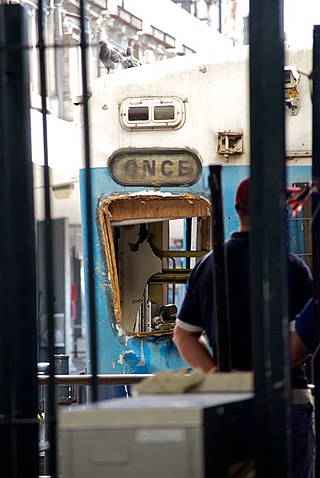
The 2012 Buenos Aires rail disaster, also known as the Once Tragedy, occurred on 22 February 2012, when a train crashed at Once Station in the Balvanera neighbourhood of Buenos Aires, Argentina.

The Brandsen rail disaster occurred on March 8, 1981, in Brandsen, a town in Buenos Aires Province in Argentina, when a passenger train carrying 803 passengers collided head-on with a freight train, killing 34 and injuring another 74. The train crash was caused by points failure.
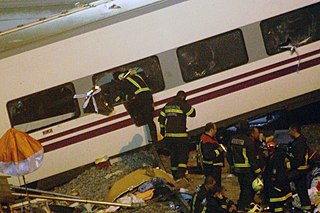
The Santiago de Compostela derailment occurred on 24 July 2013, when an Alvia high-speed train traveling from Madrid to Ferrol, in the north-west of Spain, derailed at high speed on a bend about 4 kilometres (2.5 mi) outside of the railway station at Santiago de Compostela. Of the 178 people injured, the provisional number of deaths in hospital had reached 79 by the following 28 July.

The Tren de los Pueblos Libres was an 813-km length rural railway line that connected Argentina and Uruguay, being operated by both the Argentine private company Trenes de Buenos Aires (TBA) on General Urquiza Railway standard gauge rail tracks, and Uruguayan the State-owned State Railways Administration of Uruguay "Administración de Ferrocarriles del Estado" (AFE).

The Sa Pereira accident was a train wreck in the city of Sa Pereira in Santa Fe Province which occurred on 25 February 1978, when a long-distance passenger train operated by Ferrocarriles Argentinos crashed into a truck at a level crossing between the General Mitre Railway and RN 19 in Sa Pereira.

















